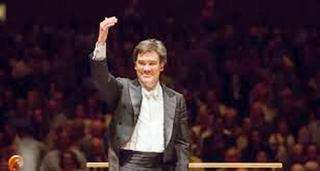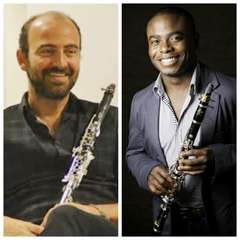|
Back
Infinite Hails and One Farewell New York
David Geffen Hall, Lincoln Center
06/08/2017 - & June 9, 2017
Kinan Azmeh: Ibn Arabi Postlude
Edward Perez/Traditional: The Latina Suite 6/8
Gustav Mahler: Symphony No. 7
Silk Road Ensemble etc: Yo-Yo Ma, Carter Brey (Cellos), Anthony McGill (Clarinet), David Druckman, Shane Shanahan, Christopher S. Lamb (Percussion), Cristina Pato (Galician bagpipes and piano), Johnny Gandelsman (Violin), Cynthia Phelps (Viola), Edward Perez (Bass)
New York Philharmonic, Alan Gilbert (Violin/Music Director/Conductor)

A. Gilbert (© nch.je)
“The symphony must embrace everything. It must be like the world.”
Gustav Mahler (1860-1911)
For his final concerts with the New York Philharmonic Orchestra, Alan Gilbert took Gustav Mahler’s famous quote literally. The Phil has a few international players, though it is mainly an American orchestra. For Mahler’s Seventh, though, in a performance called “A Concert for Unity”, Mr. Gilbert invited players from the farthest corner of the globe.
The Phil was populated with professionals from South Africa, South Korea, Mexico, the Czech Republic, Israel, Russia, the U.K., Brazil, Australia, Venezuela, Japan, Turkey, Iraq, Sweden, France, Germany, Cuba and Iran (the “Mozarteum Lyceum of Havana” and the Teheran Philharmonic’s Concertmaster. Who knew?) Four woodwinds, but the rest were in the strings, making an orchestra which almost sagged over the proscenium.
Yet since these were almost all First Chair players, nothing in the Phil was dragged down.
And adding to the Unity theme (with a screened introduction from the Secretary-General of the United Nations), the concert opened with one original work from Damascus, and another by an American who has adopted South American and Sicilian concepts for his own. These were played by members of Yo-Yo Ma’s Silk Road Ensemble (including the cellist himself), players from the Phil, and the Maestro himself as Second Violinist.
In other words, despondent as we may be at the Maestro’s farewell, he at least had that kind of original, conception which has characterized his eight years on the podium.

K. Azmeh/A. McGill (© Applehill.org/David Finlayson)
That was obvious with the first piece by Damascus-born Juilliard-educated, jazz– and classical-oriented composer Kinan Azmeh. His Ibn Arabi Postlude was a mere six minutes, but the players from Silk Road Ensemble–as well as Mr. Gilbert and violist Cynthia Phelps–offered Arabic music with the nuances of Western auras.
The lead–probably replacing the clarinet-playing composer–the Phil’s First Chair clarinet, Anthony McGill, starting with a long solo with Semitic modes, near micro-tone notes. Then joined in by David Druckman on percussion and the other players.
The short duration was too long, methought. And on a personal note, having spent several months playing accordion in a Damascus nightclub many years ago, I wanted aural reminisces. No matter. It was a fine beginning.

Y.-Y. Ma/C. Patos (© Courtesy of the Artists)
The following Latina Suite 6/8 by Texas born Edward Perez, was one of the most astonishing pieces premiered by Mr. Gilbert. And this was primarily due to Silk Road Ensembles’s Cristina Patos.
Ms. Patos is not only a fine pianist (as shown here in one movement), but she is a master of –wait for it!!–jazz on the Galician bagpipes.
Yikes!! The What??? From the Galician part of Spain and Portugal, the instrument has more than a drone and a few notes. It has a few octaves, its scale goes up to a violin/flutey top and a drone bottom. And Ms. Pato danced her way through the four movements of the work.
The music reeks of both Spain and Peru and Venezuela and Sicily, and Mr. Perez explained the ins and outs. But that was unnecessary. The audience applauded after each movement, and they were right. The Latina Suite was filled with jazzy riffs, a thesaurus of rhythms and tempos. It was an infectious extremely movable feast.
For most conductors, the valedictory work would be a D Minor (symphony) or a B Minor (Mass). Mr. Gilbert came near those classics with a Mahler symphony, a work in which the New York Philharmonic, with its superb brass and horns–and a conductor who loves those huge climaxes–can always endear audiences. In this case, though, Mr. Gilbert chose Mahler’s Seventh Symphony, so rarely played, so difficult, and so uncommercial.
The audience last night (and tonight) came to celebrate the conductor, so they sat through the 86-odd minutes of unfamiliar music without complaint. And indeed, Mr. Gilbert conducted the first four movements with deliberate pacing, with extraordinary solos (Christopher Martin’s constant high notes were like the clarion calls from a C Major trumpet!) and with as much atmosphere as the composer and percussion section could drum up.
The first movement takes a few simple themes and winds them in an round with few chances for cohesion. But the Phil’s aural performance was so good that David Geffen Hall was entranced. This, after all, was not Mahler the Mystic or Mahler the Confused. It was Mahler the relaxed, ready to experiment, to be a Titian or Caravaggio of colors. All one needed was ears. Including an unalloyed joy from those few measures which whispered a reverent “Amen” with an augmented string choir.
The two night-music movements were hardly Bartók nocturnal sounds, yet they did give some memory of Mahler’s First Symphony opening. And the third movement, while not taken riotously, had the sense of the contented composer playing his little games.
Now we come to the climax. One has the feeling that Mahler, with his interest in America, had been listening to John Philip Sousa, and why not? For this was simply blazing American brass-band music (albeit with complexity), it was music of triumph and joy and...
Well, to finish off, the cover of this month’s NY Phil Playbill shows Alan Gilbert atop a skyscraper, arms extended as he soars above New York.
That’s all? In my view, it’s too damned provincial. With his “Concert for Unity” and his near-decade of experiments, premieres, rare music and frequently the rarest of performances, he is set to conquer a world which already knows him.
He will return next November for Gershwin and Bernstein. But in these few months, to paraphrase Lorenz Hart, “New York may tumble, Rockefeller Center may crumble...” but Manhattan’s love is here to stay.
Harry Rolnick
|